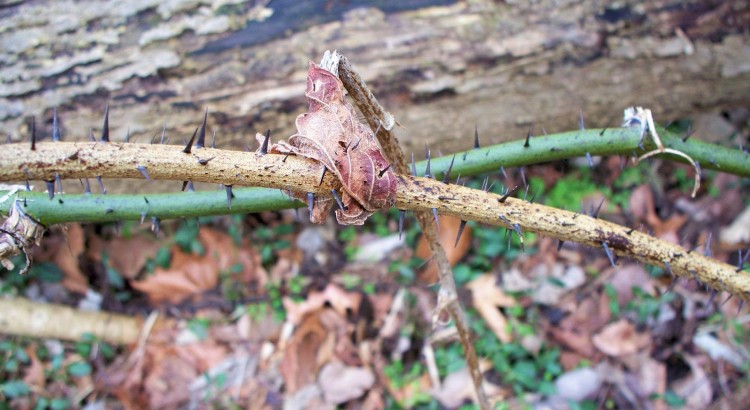
reacts, attacks, grasps, clasps…
I love you Smilax – your name slides off the tongue, your needle thorns pierce flesh, your lovely veined leaves turn yellow in fall, your rounded clusters of dark blue berries hang always out of reach.

The only thing I don’t love is wading through thickets of your tangled vines when I’ve been foolish enough to wander off trails.

But such thickets are becoming fewer in our forest and new ones will have a harder time getting started. The wicked thorns are a clue – anything needing such armor must be delicious, and smilax is. To deer of course. The tender young shoots resemble asparagus (they’re both in the lily family) and are easy to nip off when not hiding behind the thorns.

Their only hope is to get up into a tree as quickly as possible. And smilax has a remarkable way of doing this – with tendrils, in a behavior called “circumnutation”. As Charles Darwin and his son Francis first described, the tendrils of climbing plants make exploratory movements in the air. Think of swinging a rope over your head in circles till it hits a branch and grabs on.
Once a support is touched, the cellular growth in the tendril tip changes. The part that’s in contact stops growing, but on the other side it speeds up – creating a spiral growth pattern. Plant hormones, in part, direct the formation of tendrils.

- evidence of wandering – smilax tendrils
Although to write this post I waded through a bewildering amount of research on the topic of tendrils, their movements are still considered somewhat mysterious.
For me it just adds to the charm.
-Smilax the vine has fingers that twine

Susan Sheckler
I’m going to start a file on my email for your tidbits of information. I need to reread them. Thank you, again. Susan Sheckler
LikeLike
Roger Ohlman
Thanks – you’ve given me a new appreciation for smilax. I have it growing on my fence next to my AC Unit and have to cut it back each year. It is a fast grower and very resilient.
LikeLike
oneforestfragment
You must have a great yard if you have smilax! It is fast growing and resilient, but with our browse pressure it must get up a support to flower and produce berries. Rosemary
LikeLike
Rod
Smilax grows in dense thickets along the south slope of Pine Mountain in Eastern Kentucky. I’ve caught myself in its clutches more than a few times looking for wildflowers. When that happens, I try to keep in mind that it provides necessary cover for the ruffed grouse and many other ground nesting bird species.
LikeLike
oneforestfragment
You are right, it can be very dense in some locations. Great observation about shelter for nesting birds, that is an important service it provides in the forest. I suspect a dense thicket can also protect herbaceous plants and young trees from browsing. Rosemary
LikeLike